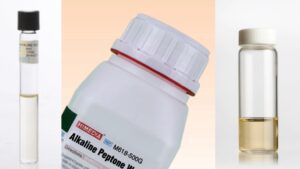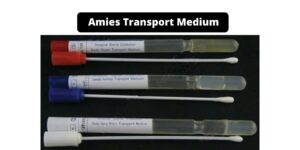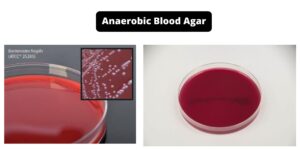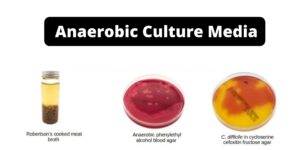What is Campylobacter Blood Agar (CVA)?
- Campylobacter Blood Agar (CVA) is a specialized medium specifically designed for the primary isolation of Campylobacter jejuni, a bacterial pathogen commonly associated with diarrhea and acute gastroenteritis. The development of CVA can be traced back to several research studies conducted by different scientists.
- In the early 1970s, Dekeyser et al. employed a filtration technique and a selective medium containing antimicrobials to isolate Campylobacter jejuni from fecal samples of patients with diarrhea and gastroenteritis. This approach aimed to suppress the growth of normal enteric flora, allowing for the isolation of the target pathogen.
- Subsequently, in 1977, Skirrow introduced a selective medium for Campylobacter isolation. This medium consisted of three antimicrobial agents. However, it was in 1978 that Blaser et al. achieved improved results by utilizing a selective medium containing four antimicrobials: amphotericin, vancomycin, polymyxin B, and trimethoprim. These antimicrobial agents were chosen for their ability to inhibit the growth of other bacteria, while allowing the growth of Campylobacter.
- Further advancements were made in 1983 by Reller et al., who introduced an enhanced selective medium for the isolation of Campylobacter jejuni. This medium contained cefoperazone, vancomycin, and amphotericin B as the selective antimicrobials. The combination of these antimicrobials was found to provide superior suppression of normal fecal flora, resulting in improved isolation of Campylobacter jejuni from fecal specimens.
- Campylobacter Blood Agar (CVA) is a variant of the selective medium developed by Reller et al. It is a solid agar medium that incorporates the antimicrobials cefoperazone, vancomycin, and amphotericin B. The use of blood in the agar formulation provides additional nutrients that support the growth of Campylobacter species. CVA selectively inhibits the growth of other bacteria while allowing for the isolation and cultivation of Campylobacter jejuni.
- In summary, Campylobacter Blood Agar (CVA) is a selective medium developed for the primary isolation of Campylobacter jejuni from stool specimens. It incorporates specific antimicrobials to suppress the growth of normal fecal flora, thus facilitating the isolation and identification of this bacterial pathogen. CVA has proven to be an effective tool in the laboratory diagnosis of Campylobacter infections.
Composition of Campylobacter Blood Agar (CVA)
| Ingredients | Gm/Liter |
| Agar | 15.0gm |
| Trimethoprim | 5.0mg |
| Casein peptone | 15.0gm |
| Meat peptone | 5.0gm |
| Sodium Chloride | 5.0gm |
| Yeast Extract | 2.0gm |
| Dextrose | 1.0gm |
| Vancomycin | 10.0mg |
| Amphotericin B | 0.2mg |
| Polymyxin B | 2500 U |
| Sodium Bisulfite | 0.1gm |
| Cephalothin | 15.0mg |
| Sheep Blood | 100ml |
| Demineralized water | 1000.0 ml |
Final pH 7.0 +/- 0.2 at 25ºC.
Principle of Campylobacter Blood Agar (CVA)
The principle of Campylobacter Blood Agar (CVA) revolves around providing an optimal growth environment for Campylobacter species while inhibiting the growth of normal microbial flora present in fecal specimens. The medium is formulated with various peptones and extracts that supply essential growth factors such as nitrogen compounds, carbon, sulfur, and trace ingredients necessary for the recovery of Campylobacter species.
To support the growth of Campylobacter, yeast extract is included in the medium as a source of B vitamins, while dextrose serves as an energy source. The incorporation of sheep blood into the agar provides hemin and other vital growth factors. These components create a favorable environment for the growth of Campylobacter species.
The selective properties of CVA are achieved through the inclusion of specific antimicrobial agents in the medium. Cephalothin, polymyxin B, trimethoprim, amphotericin B, and vancomycin are added to suppress the growth of normal microbial flora present in the fecal specimens. Vancomycin is a glycopeptide that inhibits many gram-positive bacteria, while polymyxin B inhibits most gram-negative bacilli except for Proteus species. Trimethoprim specifically targets Proteus spp., and amphotericin B is an antifungal agent effective against a wide range of yeasts and molds.
The solidifying agent in CVA is agar, which provides the necessary gel-like consistency to support bacterial growth. Additionally, Campylobacter jejuni is a thermophilic organism, meaning it thrives in high temperatures. Therefore, CVA plates are incubated at 42°C to accelerate the growth of Campylobacter species. The elevated temperature also aids in inhibiting any background flora that might be present, further enhancing the selective nature of the medium.
In summary, the principle of Campylobacter Blood Agar (CVA) involves creating a nutrient-rich environment for the growth of Campylobacter species while incorporating specific antimicrobial agents to suppress the growth of normal microbial flora. The inclusion of sheep blood, peptones, extracts, and essential growth factors supports the growth of Campylobacter, while the antimicrobials cephalothin, polymyxin B, trimethoprim, amphotericin B, and vancomycin selectively inhibit the growth of other bacteria and fungi. The incubation of CVA plates at 42°C accelerates Campylobacter growth and inhibits background flora, allowing for the successful isolation of Campylobacter species from fecal specimens.
Preparation Steps of Campylobacter Blood Agar (CVA)
- Preparation of antibiotic supplement:
- Take 10.0ml of distilled water.
- Add the specified components for the antibiotic supplement.
- Filter sterilize the solution to ensure its sterility.
- Preparation of the medium:
- Take distilled water and add the required components for the medium, excluding sheep blood and the antibiotic solution.
- Bring the volume of the solution to 890.0ml.
- Mix the ingredients thoroughly to ensure proper distribution.
- Heat and boiling:
- Gently heat the medium while stirring to avoid overheating or burning.
- Bring the medium to boiling point.
- Autoclaving:
- Transfer the medium to an autoclave-safe container.
- Autoclave the medium at 15 lbs pressure and 121°C for 15 minutes.
- This process helps to sterilize the medium, eliminating any potential contaminants.
- Cooling:
- After autoclaving, allow the medium to cool down to a temperature of 45°C-50°C.
- The medium should be sufficiently cooled to avoid damaging the blood components.
- Addition of sheep blood and antibiotic solution:
- Aseptically add 100.0ml of sterile sheep blood to the cooled medium.
- Add 10.0ml of the previously prepared sterile antibiotic solution.
- Mix the ingredients thoroughly to ensure uniform distribution.
- Pouring or distribution:
- Pour the prepared CVA medium into sterile Petri dishes if using plates.
- Alternatively, distribute the medium into sterile tubes if using a tube format.
- Take care to maintain sterility during this step.
Once the CVA medium has been poured into Petri dishes or distributed into tubes, it is ready for use in the isolation and cultivation of Campylobacter species. Proper labeling and storage of the prepared CVA medium are important to maintain its integrity and prevent contamination.
Test Procedure – Recommended Procedure
- Temperature adjustment:
- Allow the prepared CVA medium to reach room temperature before proceeding with the inoculation. This ensures that the medium is at an appropriate temperature for bacterial growth.
- Inoculation:
- As soon as the specimen is received in the laboratory, streak the specimen onto the CVA medium using a direct inoculum. The goal is to obtain well-isolated colonies.
- If the specimen is on a swab, swab directly onto the surface of the agar and streak it for isolation.
- Incubation:
- Place the inoculated CVA plates in a suitable incubator set to a temperature of 42°C.
- Create microaerophilic conditions within the incubator by reducing the oxygen levels and increasing the carbon dioxide concentration. This mimics the natural growth environment for Campylobacter species.
- Colony examination:
- After incubation, examine the CVA plates after 24 and 48 hours of growth.
- Look for typical colonies of Campylobacter species on the agar surface.
- Typical colonies of Campylobacter jejuni appear as small, grayish-white or translucent colonies with a characteristic “fried egg” appearance.
Results Interpretation on Campylobacter Blood Agar (CVA)
- Appearance of Campylobacter jejuni colonies:
- Campylobacter jejuni colonies typically appear as small, grayish in coloration, flat with irregular edges, and non-hemolytic.
- The colonies may have a mucoid appearance.
- These characteristics are observed after both 24 and 48 hours of incubation.
- Full 48-hour incubation:
- It is important to incubate the CVA plates for the full 48 hours, as some Campylobacter isolates may be barely visible after only 24 hours of incubation.
- The extended incubation allows for optimal growth and better visibility of the colonies.
- Appearance of colonies:
- Some Campylobacter jejuni colonies may appear as round colonies with a diameter of 1-2mm.
- These colonies are convex, entire (smooth edges), and glistening in appearance.
- Spreading and swarming:
- Spreading and swarming are common characteristics observed for Campylobacter isolates from fresh clinical specimens.
- These movements may result in the colonies spreading outwards or forming extended growth patterns on the agar surface.
- Further identification:
- To complete the identification of Campylobacter isolates, additional biochemical and serological tests should be performed on isolated colonies from pure culture.
- These tests help confirm the specific Campylobacter species, such as Campylobacter jejuni.
It is important to note that Campylobacter Blood Agar (CVA) may also support the growth of other thermophilic Campylobacter species, such as Campylobacter coli. Therefore, additional tests and procedures are necessary to differentiate and identify specific Campylobacter species accurately.
Interpretation of results on CVA plates provides preliminary information about the presence and characteristics of Campylobacter colonies, but further testing is required for definitive identification and confirmation of the species.
Quality Control of Campylobacter Blood Agar (CVA)
The quality control of Campylobacter Blood Agar (CVA) involves testing the completed medium using specific organisms to assess its performance. The expected results for each organism are as follows:
- Campylobacter jejuni ATCC 33291:
- Expected result: Growth
- This strain of Campylobacter jejuni should demonstrate growth on the CVA medium, indicating that the medium supports the growth of Campylobacter species.
- Escherichia coli ATCC 25922:
- Expected result: Inhibition
- Escherichia coli, a common indicator organism, should be inhibited on the CVA medium. This indicates that the antimicrobial agents in the medium effectively suppress the growth of gram-negative bacteria like E. coli.
- Candida albicans ATCC 10231:
- Expected result: Inhibition
- Candida albicans, a yeast species, should also be inhibited on the CVA medium. The presence of amphotericin B in the medium should effectively prevent the growth of Candida species.
Before conducting the quality control, several visual checks should be performed to ensure the medium’s correct pH, color, depth, and sterility. Once these checks are satisfactory, the specific organisms mentioned above are used to validate the medium’s performance.
By testing the CVA medium with these organisms and observing the expected results, it can be determined whether the medium meets the necessary quality control criteria. The growth of Campylobacter jejuni and the inhibition of Escherichia coli and Candida albicans indicate that the CVA medium is performing as expected.
Quality control is an essential step in ensuring the reliability and accuracy of the CVA medium for the isolation and identification of Campylobacter species in laboratory settings.
Uses of Campylobacter Blood Agar (CVA)
Campylobacter Blood Agar (CVA) has several important uses in the laboratory setting, including:
- Primary isolation of Campylobacter jejuni:
- CVA is specifically designed to support the growth of Campylobacter jejuni, a bacterial pathogen commonly associated with diarrheal illnesses and gastroenteritis.
- It serves as a selective medium that allows for the isolation and cultivation of Campylobacter jejuni from various specimens, including fecal samples, food samples, and environmental samples.
- Cultivation of Campylobacter jejuni:
- CVA provides an enriched environment with necessary growth factors and nutrients that support the robust growth of Campylobacter jejuni.
- The medium’s formulation, including the presence of blood, peptones, and other ingredients, promotes the optimal growth and cultivation of Campylobacter jejuni.
- Selective properties:
- CVA acts as a selective medium by incorporating specific antimicrobial agents, such as cephalothin, polymyxin B, trimethoprim, amphotericin B, and vancomycin.
- These antimicrobials suppress the growth of normal microbial flora, allowing for the selective isolation of Campylobacter jejuni from mixed specimens.
- Diagnostic applications:
- CVA plays a vital role in the laboratory diagnosis of Campylobacter infections.
- By using CVA, healthcare providers and researchers can identify and confirm the presence of Campylobacter jejuni in various clinical, food, or environmental samples.
Overall, the primary uses of Campylobacter Blood Agar (CVA) include the isolation, cultivation, and selective detection of Campylobacter jejuni from fecal, food, and environmental specimens. It serves as an essential tool in the laboratory diagnosis and research related to Campylobacter infections.
Limitations of Campylobacter Blood Agar (CVA)
Campylobacter Blood Agar (CVA) has certain limitations that should be taken into consideration:
- Incomplete identification:
- While CVA facilitates the isolation and initial identification of Campylobacter jejuni, further testing is necessary for complete identification.
- Biochemical, immunological, molecular, or mass spectrometry testing on colonies from pure culture is recommended to confirm the species and differentiate it from other Campylobacter species.
- Incubation temperature:
- CVA requires incubation at 42°C to promote the growth of Campylobacter jejuni.
- Incubation at lower temperatures may result in delayed growth and reduce the selectivity of the medium.
- It is crucial to follow the recommended incubation temperature to obtain accurate and timely results.
- Weakly positive oxidase reactions:
- Some Campylobacter isolates may produce weakly positive oxidase reactions when grown on CVA due to the presence of dextrose in the medium.
- To mitigate this issue, subculturing such isolates in a medium without dextrose and repeating the oxidase test is recommended for more accurate results.
- Inhibition of certain Campylobacter species:
- Campylobacter fetus, Campylobacter lari, Campylobacter hyointestinalis, and Campylobacter upsaliensis may be inhibited by cephalothin, one of the antimicrobial agents present in CVA.
- This limitation means that CVA may not be suitable for the isolation and detection of these specific Campylobacter species.
FAQ
What is Campylobacter Blood Agar (CVA)?
Campylobacter Blood Agar (CVA) is a specialized selective medium used for the primary isolation and cultivation of Campylobacter jejuni, a bacterial pathogen associated with gastrointestinal infections.
What are the components of CVA?
CVA contains peptones, extracts, yeast extract, dextrose, sheep blood, and specific antimicrobial agents such as cephalothin, polymyxin B, trimethoprim, amphotericin B, and vancomycin.
What is the purpose of CVA?
CVA provides a suitable environment for the growth of Campylobacter species while suppressing the growth of normal microbial flora. It enables the isolation and identification of Campylobacter jejuni from various specimens, including feces, food, and environmental samples.
How does CVA selectively inhibit normal flora?
The antimicrobial agents present in CVA, such as vancomycin, polymyxin B, and trimethoprim, target specific groups of bacteria and fungi, inhibiting their growth and allowing Campylobacter species to thrive.
What is the recommended incubation temperature for CVA plates?
Incubation at 42°C is recommended for CVA plates. This higher temperature promotes the growth of Campylobacter species and inhibits the growth of background flora that may be present.
Can CVA be used to identify other Campylobacter species?
While CVA is primarily designed for the isolation of Campylobacter jejuni, it may also support the growth of other thermophilic Campylobacter species, such as Campylobacter coli. Additional tests are required to differentiate between different Campylobacter species.
How long should CVA plates be incubated?
CVA plates should be examined after 24 and 48 hours of incubation. Some Campylobacter isolates may show visible growth after 24 hours, but a full 48-hour incubation is necessary to ensure accurate and complete identification.
What are typical colony characteristics of Campylobacter jejuni on CVA?
Campylobacter jejuni colonies on CVA appear as small, grayish, flat colonies with irregular edges. They are non-hemolytic and may have a mucoid appearance.
Is additional testing required for complete identification?
Yes, further biochemical, immunological, molecular, or mass spectrometry testing should be performed on colonies from pure culture to achieve complete identification of Campylobacter species.
What are the limitations of CVA?
Limitations of CVA include the need for additional tests for complete identification, the requirement for proper incubation temperature, the potential for weakly positive oxidase reactions, and the inhibition of certain Campylobacter species by cephalothin.
References
- https://www.dalynn.com/dyn/ck_assets/files/tech/PC24.pdf
- https://assets.fishersci.com/TFS-Assets/LSG/manuals/IFU1280.pdf
- https://www.bd.com/resource.aspx?IDX=8966
- https://hardydiagnostics.com/media/assets/product/documents/CampyBloodAgar.pdf
- https://anaerobesystems.com/products/plated-media/campylobacter-agar-campy/



